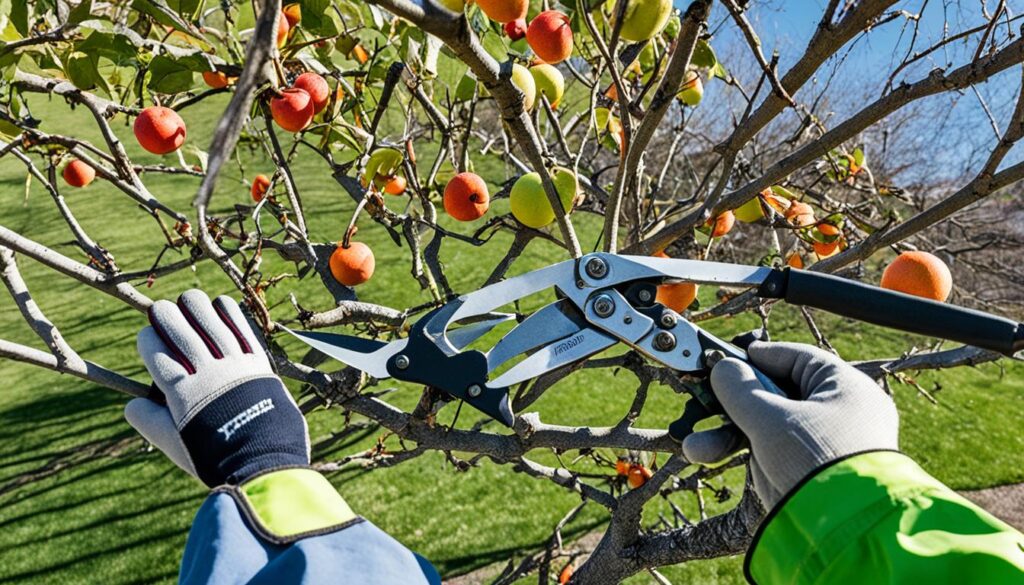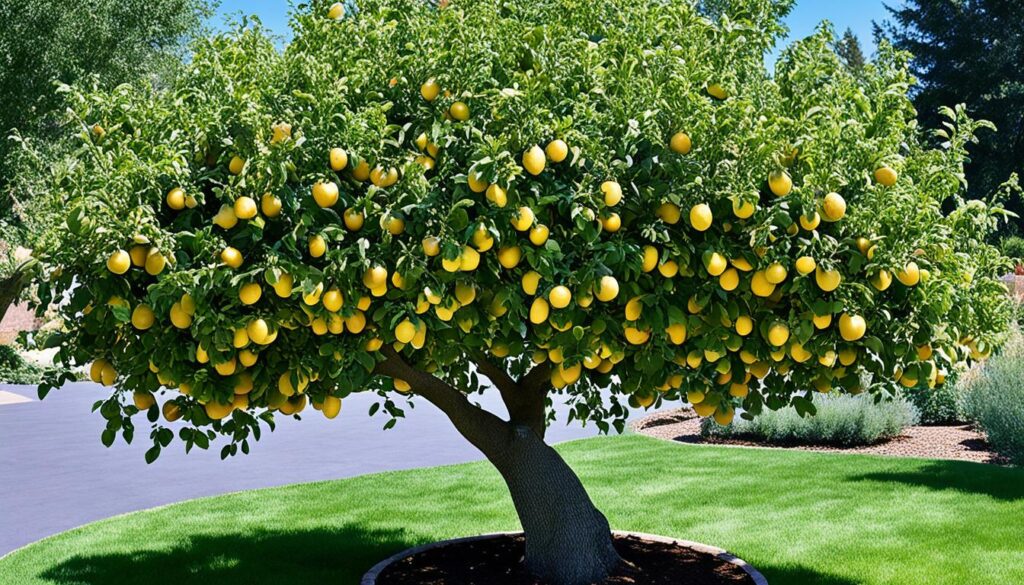Want to make your fruit trees grow better and give you more fruit every year? The key is to learn how to prune them right. Pruning helps your trees grow strong, boosts their size, and makes the fruit taste better. We’ll show you the best ways to prune your trees in this guide.
Pruning your fruit trees is very important for their health and how much they produce. By pruning correctly, you can shape the tree, let more sunlight in, and get more fruit. No matter if you’re an expert or new to growing fruit trees, these pruning tips will help you do great.
Why Prune Fruit Trees?
Pruning fruit trees has many benefits. It helps make a strong tree that can carry heavy fruit without breaking. It also makes trees start producing fruit early.
Structural Benefits
Proper pruning makes a tree strong and well-shaped. This helps it carry a big harvest without breaking. It keeps the tree healthy for a long time.
Practical Benefits
Pruning also makes trees easier to spray and pick fruit. It makes the tree smaller, which helps with spraying and picking. This means more fruit and better quality.
Pruning can also make older trees more productive and improve fruit quality. By removing some branches, trees focus on growing the best fruit. This leads to bigger, tastier fruit.

Pruning Basics and Terminology
Before you start pruning fruit trees, learn the key terms. The branch collar is the raised tissue at a branch’s base. The crotch angle is the angle where the trunk meets a limb. Knowing these terms helps you prune better.
A heading cut cuts part of a branch off. A thinning cut removes a whole branch from its start. Learning these cuts is key to keeping your trees strong and fruitful.

Proper fruit tree pruning keeps them healthy and growing well. With the right pruning terms, you can prune with confidence and skill.
General Pruning Rules
Proper pruning is key for your fruit trees’ health and productivity. By following some basic rules, your trees will thrive and give you lots of fruit. Let’s look at the fruit tree pruning rules for timing, treating wounds, and pruning young versus mature trees.
Pruning Timing: Prune your fruit trees in the dormant season. This is after the fall or early winter freezes and before spring blooms. This helps the trees grow new and produce more fruit.
Wound Treatment: Don’t use wound dressings on pruning cuts. They don’t stop wood rots and can slow healing. Let the tree heal itself to fight off disease.
Pruning Young vs. Mature Trees: Be gentle when pruning young trees. They need little pruning to grow strong. Mature trees can take more pruning to keep their shape and produce more fruit.
Always cut just outside the branch collar on any tree. This helps them heal right. By following these general pruning rules, your fruit trees will stay healthy and productive.

Fruit Tree Training Systems
Choosing the right training system is key to growing healthy fruit trees. There are different ways to train fruit trees, each with its own benefits. Open center training is great for stone fruits like peaches and nectarines.
Open Center Training
This method picks three to four main branches that form a vase shape. It lets sunlight and air get into the tree easily. This makes the fruit better and helps prevent diseases.
This way, the tree grows well and is easy to take care of. It’s perfect for people who want a simple way to manage their trees.
On the other hand, central leader training is for apples and pears. It keeps a single trunk in the middle with branches around it. This makes the tree look neat and tall.
Espalier training trains trees to grow flat, saving space and making gardens look nice. It’s great for small gardens.
Choosing a training system depends on the fruit type, space, and what you like. Knowing about these methods helps you pick the best one for your trees.

| Training System | Suitable Fruit Types | Key Benefits |
|---|---|---|
| Open Center | Peaches, Nectarines | Promotes sunlight penetration, air circulation, and easy management |
| Central Leader | Apples, Pears | Creates a structured, pyramidal shape for the tree |
| Espalier | Various Fruit Trees | Saves space and enhances the aesthetic appeal of the garden |
Central Leader Training
If you want to grow healthy fruit trees, try the central leader training method. It’s great for apples, pears, and European blue plums. This method makes a strong, single trunk with scaffold limbs around it.
To start, pick a strong shoot in the tree’s center and cut down any other shoots. Every year, cut the top leader by one-third. Also, spread any branches that grow too straight to keep the tree’s shape. This helps the tree grow strong and full of fruit.
- Select a vigorous central leader shoot and remove competing shoots.
- Annually, head the central leader by one-third to control tree height.
- Spread any overly upright lateral branches to maintain the pyramidal shape.
This training method has many benefits. It lets more light and air into the tree, which helps with fruit growth and tree health. By using this pruning, you get a tree that looks great and gives lots of fruit every year.

fruit tree pruning techniques
Proper pruning is key for your fruit trees’ health and productivity. You should learn fruit tree pruning techniques, thinning out, heading back, and branch bending.
Thinning Out
Thinning out means cutting some branches. This leaves long, flexible limbs that can carry heavy fruit. It also lets more light and air into the tree.
Heading Back
Heading back cuts a branch to a lateral one. This makes the tree branch out more and keeps it strong. It stops the tree from growing too much in unwanted places.
Branch Bending
Bending branches to 45-60 degrees makes them produce fruit sooner. It uses the tree’s energy for fruit instead of just growing.
These pruning methods are vital for your fruit trees’ health and yield. Learning them means you can have lots of fruit and a nice-looking orchard.
Pruning at the right time is important. Do big pruning from November 15 to April 15 when the tree is dormant. Summer pruning is okay too, but be careful not to harm the tree.
Using these pruning techniques will help your fruit trees grow well. You’ll get a lot of fruit for many years.
Pruning Tools and Safety
Proper fruit tree pruning needs the right tools and safety steps. To get it right, use sharp, clean pruners, loppers, and saws for clean cuts. Also, clean your tools between trees to stop diseases from spreading.
Always wear protective gear like gloves, eye protection, and strong shoes when pruning. More trees are killed or ruined each year from improper pruning than by pests. So, using the right tools and following safety steps is key.
- Scissor action shears are for cutting stems up to 1/2 inch in diameter.
- Lopping shears (loppers) can cut material up to 2 inches in diameter, depending on the species and condition.
- A good general-purpose pruning saw should have a stainless steel or carbon steel blade less than about 45cm (18in) long.
- The loppers should be able to handle branches or soft fruit canes up to about 2.5cm (1in) thick.
- Hand pruners, also known as secateurs, are for pruning twigs and soft fruit canes less than about 1cm (0.5in) thick.
When picking pruning tools, choose high-quality ones that fit well to avoid getting tired. Investing in great hand pruners and loppers with ratchet mechanisms makes the job easier and more efficient.
By using the right tools and following safety steps, you can have a successful and safe pruning experience for your fruit trees. Doing it right now will help you later.
Pruning for Fruit Tree Health
Keeping your fruit trees healthy is key, and pruning is a big part of that. By cutting off dead, sick, or broken branches, you stop pests and diseases from spreading. This also lets more air and light into the tree, which helps fight off fungal diseases like brown rot.
Pruning often stops water sprouts and suckers from growing. These can take energy away from branches that make fruit. By directing the tree’s energy to the right places, you get more fruit and a healthier tree.
The best time to prune is in late winter or early spring, just before or after the flowers fall off. This helps the tree stay strong and healthy. Don’t prune stone fruit trees from January to March, as it can spread diseases like cytospora canker.
By pruning your fruit trees carefully, you keep them fruit tree health up. You stop pests and diseases from spreading and control water sprouts and suckers. These steps are key to a full and healthy orchard.
Specialized Pruning Techniques
While basic pruning works for most fruit trees, some trees need special care. Espalier training grows trees flat, perfect for small spaces. Palmette training makes a tree look good and produce well. For big trees, pruning can make them shorter and more productive.
Espalier training makes branches grow flat, often on a trellis. It’s great for gardeners with little space. Palmette training makes a tree look like a fan with many branches. Both methods need careful training but look great and produce a lot of fruit.
For big trees that are too big or not producing well, selective pruning helps. By cutting old, unproductive branches, the tree grows new, healthy ones. This process, called rejuvenation pruning, can take a few years but makes the tree last longer and produce more.



